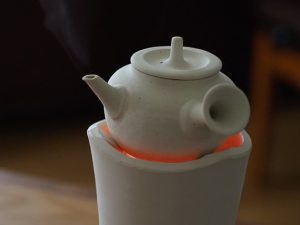
Western and Chinese teapots usually have an upper or back handle.
Have you wondered why the traditional Japanese teapot has a side handle?
To answer this question, let’s take a look at the history of the kyusu teapot.
Where did the kyusu come from?
The custom of loose leaf tea drinking came to Japan from China.
Before that, tea in Japan was ground into a powder, which was the way that it was being drank in China.
It’s believed that the Chinese Buddhist monk Ingen Ryūki (隠元隆琦, Yinyuan Longqi) was largely responsible for the introduction of loose leaf tea to Japan in the early Edo period, although there isn’t definite proof about it.
Baisao continued to popularize this new way to drink tea, by using Chinese utensils. One of them being the kyusu as we know it today.
Interestingly, the Chinese didn’t use those side handled utensils for tea.
Since ancient times, they were used to boil water and heat liquor.
The bofura (ボーフラ) used in senchado (the Japanese loose leaf tea ceremony) has the shape of the kyusu, but it has no filter because it is only used to boil the water for tea.
Apparently, Baiso used the Chinese side handle vessel to brew tea.
As time went by, people in Japan started to make their own teapots because buying Chinese teaware was expensive.




